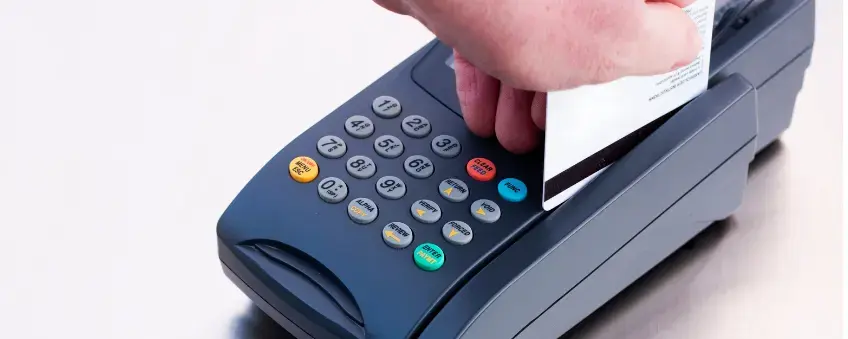Modern day consumers often look for flexible payment options when making purchases, making it challenging for businesses to avoid payment processing costs. Businesses seeking to avoid processing fees often resort to fee-reduction measures, such as cash discount programs or surcharges. However, if you plan to use a cash discount program or similar alternative, it's critical to understand how it works and the potential risks.
This guide explores cash discount programs, non-cash adjustments, cash discount regulations, alternatives to cash discounts, and a range of related topics. Dive in to discover various strategies that can help reduce your business's payment processing expenses!
What Is a Cash Discount?
A cash discount is a reduction in price offered to customers who opt to pay with cash instead of a credit card. Typically, this discount is slightly less than the fee a credit card company charges for processing the transaction.
Implementing a cash discount for retail customers paying in cash can benefit your business in various ways. First, it cuts down the costs associated with credit card fees, thereby improving profit margins. Second, it ensures immediate access to funds, enhancing your cash flow and minimizing delays from processing times. Additionally, customers often appreciate the discount, which can enhance loyalty and encourage repeat business. Overall, adopting this strategy can lead to savings and strengthen both financial stability and customer relationships.
How Does a Cash Discount Program Work?
To launch a cash discount program, first your business needs to determine the discount amount. This should be lower than your credit card processing costs (to save money) yet substantial enough to motivate customers to pay in cash. Once you've set the discount, advertise it prominently at the checkout area. Additionally, consider promoting it online and at your business's entrance to inform your customers.
When a cash-paying customer checks out, your staff should apply the discount to the total bill. To minimize errors, ensure your POS system includes a cash discount feature. Consulting with a merchant service provider about implementing this program can help ensure it operates efficiently and complies with legal requirements.
What is a Non-Cash Adjustment?
A non-cash adjustment, also known as a surcharge, is a strategy used by merchants to offset credit card processing costs. Unlike a cash discount, which lowers prices for cash transactions, a non-cash adjustment adds a fee to credit card transactions. It's important to comply with legal regulations and card network rules when implementing such adjustments. Note: surcharging is illegal in some U.S. states.
Is Offering a Cash Discount Program Legal?
Yes, cash discount programs are legal in all 50 U.S. states. However, be aware that specific states and card brands may have unique rules regarding these programs. It's essential to stay compliant with regulations relevant to your business location and operations.
Other fee-reduction strategies, like surcharges, don't have the same legal status as cash discount programs. Before adopting any strategy to lower transaction fees, thoroughly investigate the legal implications.
Cash Discount Rules and Regulations
As previously mentioned, the rules and regulations for implementing a cash discount program vary by state and card brand. However, there are best practices to ensure your program is responsibly formed:
- Clearly advertise your cash discount at your store's entrance and checkout area.
- Offer a fixed discount for cash payments.
- Display the cash discount on customer receipts.
- Utilize a POS system with an automatic cash discount feature to minimize errors.
Remember, consulting with a merchant service provider is the best way to ensure your cash discount program complies with all rules and regulations.
What Are Surcharges?
Surcharges are additional fees for customers who pay using certain methods, like credit cards. These fees help offset the business's transaction processing costs. Often a percentage of the purchase amount, surcharges aim to recoup some of the costs associated with card payments. While they can improve profit margins, surcharges may deter customers due to the extra expense. Surcharges must adhere to legal regulations and card network rules to prevent disputes and other issues.
Cash Discount vs. Surcharge
Cash discounts and surcharges represent two distinct strategies for managing credit card processing fees. A surcharge program adds an extra fee for credit card payments to cover processing costs. However, these are legally regulated and in some states, completely prohibited.
Conversely, a cash discount rewards customers who pay with cash or non-credit methods. This approach is typically seen as more customer-friendly and is generally simpler to implement than surcharges.
Both strategies have their benefits and drawbacks, and the choice depends on the business's preferences, legal considerations, and desired customer experience.
Downsides of a Surcharge Program
Before choosing a surcharge program over a cash discount, consider its potential disadvantages:
1. Negative customer sentiment: Modern consumers expect flexible payment options. Implementing surcharges can create customer dissatisfaction, especially as they're not common. This can result in a negative perception compared to competitors.
2. Varying legal status: Surcharges are regulated and, in some regions, illegal. Non-compliance can lead to legal issues, including fines or lawsuits. It's crucial to clearly disclose surcharges, apply them consistently, and adhere to card network guidelines.
3. Extra administrative work: Managing surcharges involves additional administrative tasks, which can lead to calculation errors and customer dissatisfaction.
4. Fewer payment options: Many merchant service providers do not support surcharge programs, limiting the payment options that are available to you.
Why Would a Vendor Offer a Cash Discount to a Customer?
There are many reasons a vendor may offer a cash discount to a customer — let's explore the top four below:
Reducing Transaction and Processing Fees
One of the primary reasons a merchant may choose to implement a cash discount is to reduce exposure to transaction and processing fees. Research suggests the average processing fees are around 2.24%, but this figure can often be much higher, especially for businesses in high-risk industries.
Incentivizing Cash Payments
Cash payments are processed immediately, providing instant access to funds without processing fees or delays. Cash also eliminates the risk of chargebacks or payment disputes, reducing administrative burdens and potential losses. Furthermore, businesses can often negotiate better deals with suppliers when paying in cash, potentially securing discounts or favorable terms.
Simplifying Financial Statements and Transactions
Encouraging non-credit payment methods through cash discounts simplifies accounting processes by making transaction costs more predictable. This leads to clearer financial statements and reports, aiding in the financial analysis of the company.
Minimizing the Risk of Fraud
Lastly, while credit card processing firms and payment gateway providers have a strong emphasis on security, credit card transactions are prone to fraud. Whether it's a scammer stealing a physical card and using it for contactless payments or an online fraudster obtaining stolen card details, credit card fraud can lead to substantial losses for merchants.
All of this isn't to say cash payments aren't prone to fraud either. Counterfeit bills can leave merchants out of pocket. While it's only estimated that 6.5 out of every million bills is counterfeit in the United States, scammers are growing increasingly sophisticated at developing fake currencies. Some counterfeit cash is almost undetectable. If your business accepts a large quantity of cash, always use counterfeit detection devices to minimize your risks (especially if you accept high-value notes!).
How to Efficiently Implement Cash Discounting
If your business plans to use a cash discounting program, it's critical the implementation process runs smoothly. Your business's reputation may suffer if issues arise during a customer's checkout experience. Let's explore a couple of factors to consider when building your cash discount program:
Pricing Adjustments
To ensure pricing adjustments occur efficiently, it's critical to use a POS platform with automatic cash discount features. Manually adjusting the price of goods and services may result in costly errors. Likewise, automated cash discounts make the checkout process much quicker, improving the overall customer experience.
Clear Signage and Communication
Ensure your cash discount program is well-advertised and understood. Clear in-store signage and communication across various channels can encourage customers to bring cash, enhancing participation and satisfaction.
Alternatives to Cash Discount Credit Card Processing
If your business wants to save money on payment processing but doesn't want to deal with the complexities of a cash discount program, there are a few alternatives:
Cash-only payments
If you can't stand the thought of payment processing fees, you can run a cash-only business. However, make sure to clearly communicate this to customers, as many Americans no longer carry cash.
While this might sound like a good idea for saving money, it will likely impact your business negatively in the long run. Modern consumers want payment flexibility, and many prefer using credit cards and digital wallets. In fact, evidence suggests around 45% of American consumers are willing to avoid a business if it has a cash-only policy.
Internalize costs in pricing
Incorporating payment processing costs into the price of goods and services, rather than applying a surcharge or cash discount, offers several advantages. Firstly, it simplifies pricing for customers, promoting transparency and avoiding potential resentment or confusion associated with overt price adjustments. Customers prefer upfront and predictable pricing, enhancing their trust in the business.
Secondly, embedding processing costs into the prices allows the business to maintain consistent pricing strategies, making it easier to compete in the market. With surcharges or cash discounts, customers may perceive the business as less competitive or feel that they're being penalized for their choice of payment method.
Lastly, it can be a marketing advantage. Businesses can advertise "no hidden fees" or "all-inclusive pricing," attracting customers looking for simplicity and fairness. While absorbing processing costs might impact profit margins slightly, the advantages in customer satisfaction, competitive positioning, and marketing can make it a more favorable approach for many businesses.
Affordable merchant service providers
If your business prioritizes keeping processing costs low, partnering with an affordable merchant service provider is an excellent alternative to implementing a cash discount program. While credit card processing can be expensive if you use payment service providers (PSPs), such as PayPal, Square, and Stripe, there are huge savings associated with using a merchant account to process payments.
Shopping around for an affordable merchant service provider can help reduce merchant account fees without implementing an inconvenient cash discount program that may alienate some of your customers.
Is Cash Discounting Right for Your Business?
Payment processing costs are increasing, and many businesses have no choice but to pass fees onto customers. Research suggests the average American spent an additional $900 in "swipe fees" in 2021. If you decide it's time to reduce costs for cash-paying customers, a cash discount program may be a suitable solution.
Alternatively, working with a merchant service provider to identify affordable payment processing services can help your business save money on credit card transactions. Merchant service providers can offer guidance to ensure your business's cash discount or surcharge programs comply with state laws and card brand requirements. Likewise, they have a range of payment products and insights designed to help businesses reduce payment processing costs.
Frequently Asked Questions (FAQs)
In accounting terms, a cash discount is an expense. A cash discount should have a separate entry as an expense in a business's accounts.
A cash discount occurs when a business reduces the cost of a product or service for customers willing to pay in cash (instead of with a credit card). Let's explore an example:
- A business displays a sign on its front window and checkout counter explaining all customers paying cash receive a 3% discount on products or services.
- A customer proceeds to the checkout counter with $10 worth of food, intending to pay in cash.
- The store's staff member will use the business's POS system to calculate the order total and apply a cash discount (with many POS systems, this can be done automatically).
- Assuming the store is in a state with no sales tax on food, the customer will receive a $0.30 discount on the food products for a total cost of $9.70.
Tax rules on cash discounts may vary from state to state. For example, some states have decided cash discounts are not tax deductible for sales tax purposes.
If you want to sell your cash discount program to customers, it's critical to communicate the offer clearly. Start by advertising the cash discount at the front of your store and checkout location. Likewise, communicating the cash discount program to regular customers via email and other channels can help individuals remember to bring cash to your store before their next visit.
Secondly, make sure your POS system can automatically adjust prices for customers accepting the cash discount offer. Modern consumers expect payment convenience. If your POS system requires staff to manually adjust order totals, it may lead to a subpar checkout experience for your customers.






